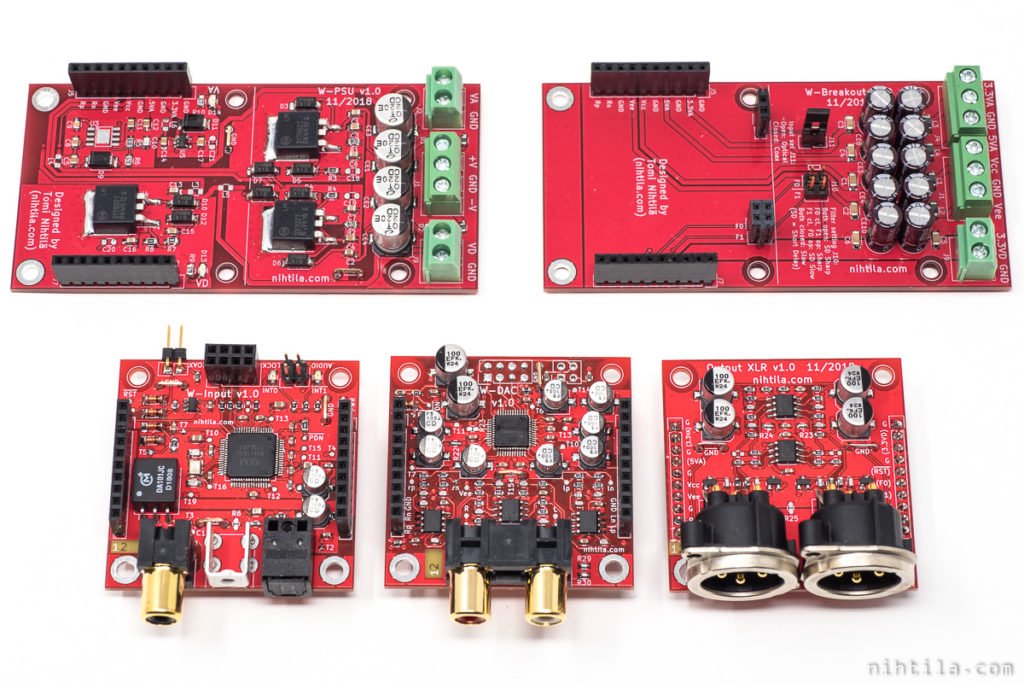Currently on test bench is a new stackable modular DAC design, Wee DAC (maybe should have called it Tower DAC!), consisting of several modules:
- W-Input – S/PDIF input board with one coaxial and one Toslink input, and I2S output
- W-DAC – High performance 768 kHz 32-bit DAC with I2S input and single-ended analog output
- W-Output XLR – Balanced output module
- Several base board options, such as W-Breakout for signal breakout and W-PSU for individual power supplies
The aim of this project has been to design versatile and compact but high performance modules for reasonable cost.
Wee DAC modules
These boards are stackable and designed to be used together but can be used in other systems as well. For example, W-DACs can be used with a 3rd party DSP with I2S outputs to build a high performance multi-channel system.
W-Input
S/PDIF input board based on AK4115VQ. There is one isolated coaxial input and one Toslink input. Output is I2S.
W-DAC
High performance DAC based on AK4490EQ, a 768 kHz / 32-bit DAC (although this high sample rates or bit depth cannot be used with W-Input as S/PDIF does not support such formats). Output stage is a third order filter around LM4562 (or alternatively NE5532, or any dual opamp) opamps followed by single-ended outputs.
W-Output XLR
Balanced output board addon for W-DAC, based on similar filter structure to W-DACs output stage.
Base boards
Power is provided via base board. W-Breakout is a simple breakout board routing power supplies on screw terminals, while W-PSU has regulators for all five supplies.
There is a plan to design a larger 100x100mm version of the W-PSU for two Wee DAC stacks.
Form factor
One design goal has been small form factor so that it is easy to fit several DACs in one enclosure for multi-channel solutions; one can fit 8-channel solution in a 20 cm wide enclosure. To support this, modules stack on top of one another, keeping footprint small. W-Input, W-DAC, and W-Output XLR are 50×50 mm and current base boards 50×100 mm.
In order to fit these designs in such small boards, 0603 components have been used instead of usual 0805s. In addition, all 50×50 mm boards are 4-layer PCBs to allow such tight mixed signal design.
Availability
The plan is to offer at least W-Input and W-DAC with all SMD components soldered, probably W-Output XLR as well. When the boards have been comprehensively tested, I will ask for quotes on assembling a small batch. Final price remains unknown until that but the plan has been to make these ‘affordable’ – do not expect Chinese cheap though!
I do not want to commit on any deadlines, but I have only built the prototypes during holidays. Everything seems functional so the next step is to run audio performance tests, various more comprehensive tests and possible check component optimisations. I hope I could offer assembled boards in the first quarter of 2019.
Stay tuned!


8 comments
Looks super neat! Looking forward for the full details!
By the way, what do you mean by single ended output? What are you going to drive with it?
Single-ended just means ground-referenced = unbalanced = RCA in audio world. As opposed to XLR is differential/balanced.
Output level is 2V by default in RCA and 4V in XLR but there are extra resistor placeholders on bottom side to lower the gain/level if necessary, without changing top-side resistors.
Ah right. Thank you for explaining!!
I strongly suspect that the AKM is better than the TI?
Which TI are you referring to? If PCM1794A I’ve used in H-DAC, no it is not. But AKM4490EQ is three times cheaper.
Unlike most of my previous projects, this one does have price constraints (as well as size). This is the first project I have developed small batch production in mind, as opposed to H-DAC which was just a one-off personal project. Being the first boards I am planning to get assembled at some point, there are risks involved. Making for example 100 boards cost some money as well so the BOM cost must be reasonable. Anyway, I do have plans to use higher end chips (both TI and AKM) in the future as well! Nevertheless, I expect Wee DAC performance not to be too far from H-DAC.
I’m looking forward to the measurements.
When you said “isolated coaxial input” I never thought you would have an actual transformer and that it would be done in a “clever” way. Then I noticed the small black box! Didn’t knew that they made them this small. And it’s cheap too! Good to know. 😀
Yes, that’s the way to do it. I have used Pulse transformers before but now switched to Murata as those are a lot cheaper.
Comments are closed.